Do you own a 1991 Lincoln Penny and wonder whether it’s an antique coin worth lots of money?
Then this guide is for you!
While the 1991 penny isn’t particularly rare or valuable yet, it holds potential for future appreciation. It’s still considered a modern coin, being only a little over 30 years old, but savvy collectors understand that long-term investments can pay off—especially with high-grade coins and rare mint errors.
In this comprehensive guide, we’ll cover everything you need to know about the 1991 Lincoln Memorial Penny. You’ll learn about its mint history, unique features, grading tips, and most importantly, the errors and top-selling examples that can command hundreds or even thousands of dollars in the current market.
1991 Penny Value Chart
| Mint Mark | MS 63 | MS 65 | MS 66 | MS 68 |
|---|---|---|---|---|
| 1991 No-Mint Mark (P) | $6 | $10 | $15 | $340 |
| 1991-D (Denver) | $6 | $10 | $18 | $130 |
| 1991-S (Proof) | $2 | $4 | $5 | $7 |
Note: Values listed are for coins graded Red (RD). Red coins are the most desirable in modern copper coinage.
History of the 1991 Penny

The 1991 Lincoln Penny is part of the long-running Lincoln cent series, first introduced by the United States Mint in 1909 to honor President Abraham Lincoln, one of the most respected and admired leaders in American history.
This iconic coin replaced the Indian Head cent, which had been in circulation since 1859. The move was strongly championed by President Theodore Roosevelt, who believed that U.S. coinage needed a more modern and artistic touch. He also wanted to see an actual person featured on circulating coins—a first in U.S. history.
To initiate the redesign, Roosevelt hired renowned sculptor Augustus Saint-Gaudens to reimagine several denominations, including the cent. Unfortunately, Saint-Gaudens passed away in 1907 before completing the cent’s design, having only managed to redesign the four gold coins.
With time running short before Lincoln’s 100th birthday, the Mint turned to Victor David Brenner in 1909. Brenner was tasked with designing a penny that would depict President Lincoln on the obverse—a tribute to the president’s legacy.
From Wheat Penny to Memorial Cent
Brenner’s original design featured Lincoln’s portrait on the obverse and two wheat ears on the reverse, leading to the nickname “Wheat Penny” for coins minted between 1909 and 1958.
Initially, Brenner included his initials “V.D.B.” prominently on the reverse, but public criticism led the Mint to remove them shortly after the coin’s release. The initials were later restored in 1918, this time in much smaller font on Lincoln’s shoulder, where they remain today.
The Wheat Penny’s composition was 95% copper until 1943, when the Mint temporarily switched to zinc-coated steel due to wartime copper shortages. In 1944, copper returned until 1982, when rising costs prompted the Mint to adopt a new composition of zinc with a thin copper coating, which is still used today.
In 1959, to mark Lincoln’s 150th birthday, the reverse of the coin was redesigned by Frank Gasparro to feature the Lincoln Memorial, replacing the wheat ears. This version is commonly referred to as the Lincoln Memorial Cent—the type struck in 1991.
The Features of the 1991 Penny
The Obverse of the 1991 Penny
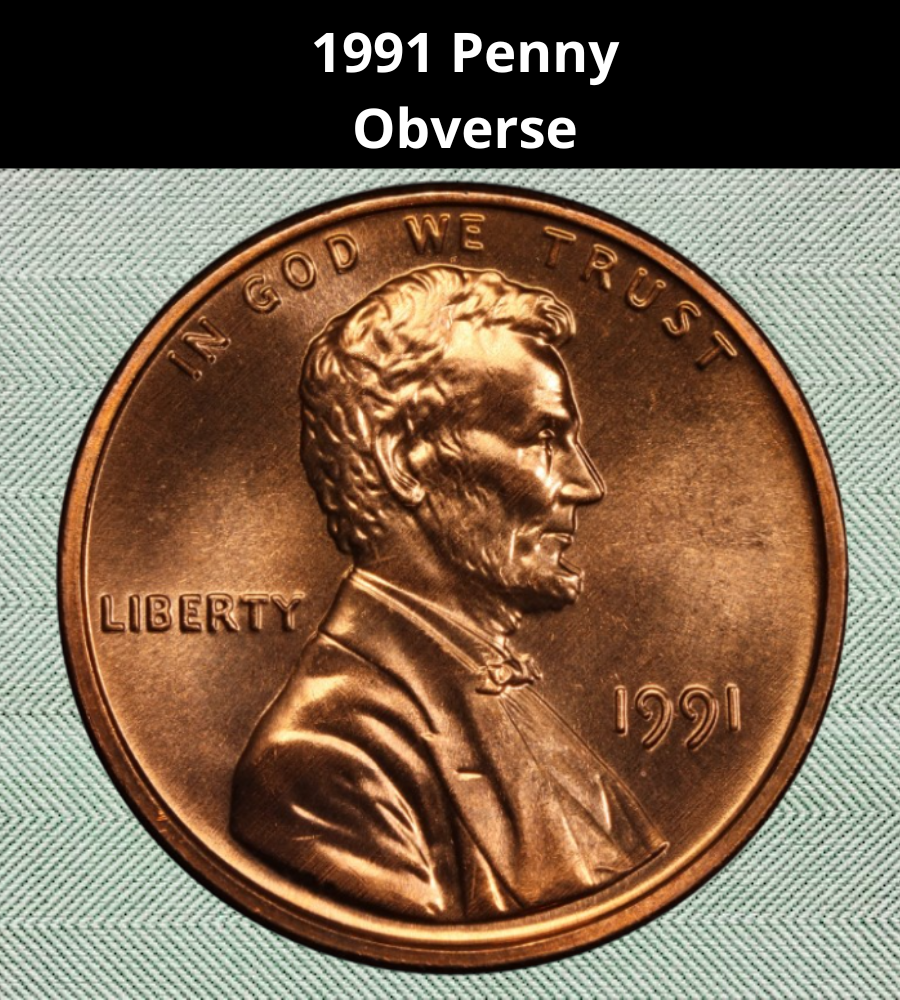
The obverse of the 1991 Lincoln Penny features a right-facing portrait of President Abraham Lincoln, occupying the majority of the coin’s surface. He is depicted wearing a formal tuxedo with a bowtie, a nod to his iconic 19th-century appearance.
Above Lincoln’s head, along the top rim, the national motto “IN GOD WE TRUST” is inscribed in capital letters.
To the left of Lincoln’s profile, just behind his back, is the word “LIBERTY”, also in uppercase.
The minting year, “1991,” appears to the right of Lincoln’s chest, completing the coin’s classic and balanced obverse design.
The Reverse of the 1991 Penny
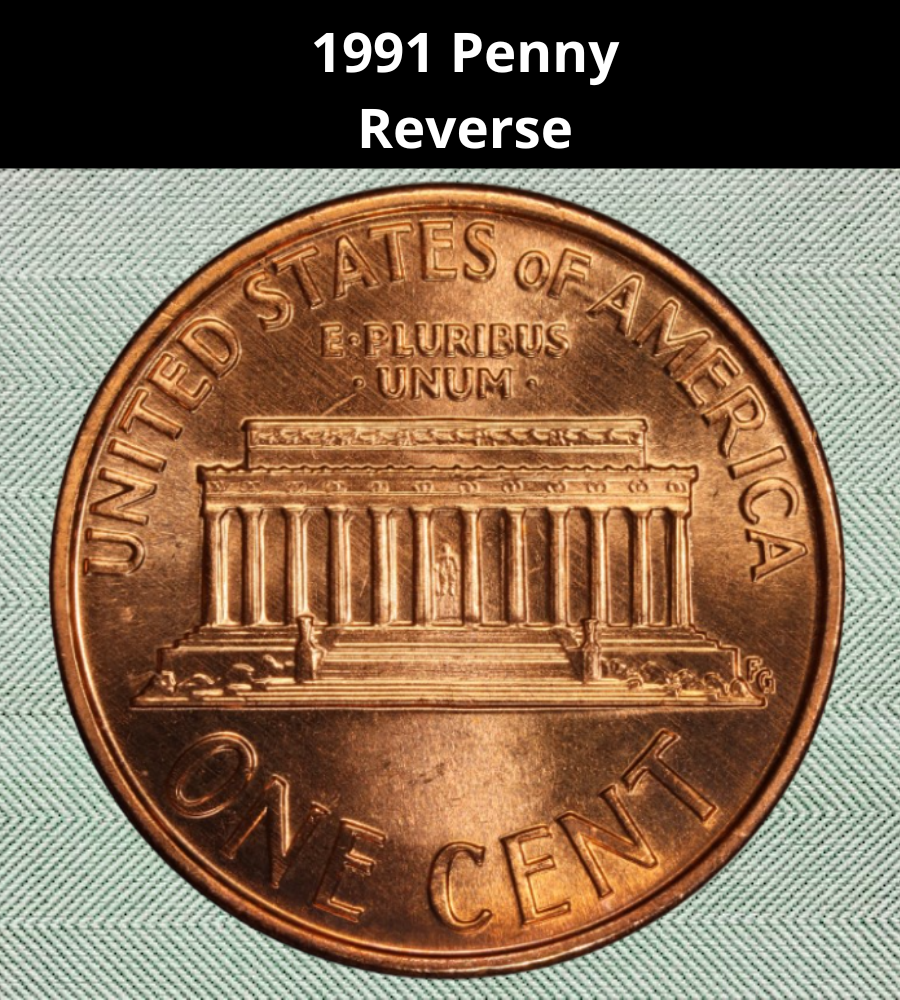
The reverse of the 1991 Lincoln penny showcases the Lincoln Memorial, designed by Frank Gasparro. This architectural depiction is highly detailed, featuring the building’s columns, stairs, and the seated statue of Abraham Lincoln visible within the center of the memorial.
At the top edge of the coin, the inscription “UNITED STATES OF AMERICA” appears in bold capital letters. Just below that, the motto “E PLURIBUS UNUM”—Latin for “Out of many, one”—is centered above the memorial.
The coin’s denomination, “ONE CENT,” is prominently displayed along the bottom edge, completing the reverse design.
Other Features of the 1991 Lincoln Penny
- Composition: The 1991 penny is made of copper-plated zinc (97.5% zinc, 2.5% copper), a composition introduced in 1982 to reduce minting costs.
- Diameter: 19 millimeters
- Weight: 2.50 grams
- Edge: Plain (smooth with no reeding)
Color Variations
Depending on its condition and exposure to circulation, the 1991 penny appears in one of three color designations:
- Red (RD): Least circulated; retains original mint luster and is the most valuable
- Red-Brown (RB): Moderately circulated
- Brown (BN): Heavily circulated; least valuable
Mint Marks
Three mints struck Lincoln cents in 1991:
- Philadelphia Mint: No mint mark
- Denver Mint: Marked with a “D”
- San Francisco Mint: Struck only proof coins, which also lack a mint mark
Grading the 1991 Lincoln Penny
When determining the value of a 1991 Lincoln Memorial cent, grading is crucial. While these coins are common, their value increases significantly with better grades and original red color. Here’s what to look for:
Primary Grading Factors
- Wear
The most important aspect of grading circulated coins is the degree of wear. Key high points to inspect on the obverse (front) include:- Lincoln’s beard
- Hair above the ear
- Lower shoulder and jawline
- Strike Quality
For a coin to achieve MS67 or higher, it must be:- Sharply struck
- Free of any noticeable weak spots in the finer details (e.g., the steps of the Lincoln Memorial or the texture of Lincoln’s coat)
- Luster and Surface Preservation
While a coin may appear glossy at first glance, use a jeweler’s loupe (10x magnification) to check for:- Contact marks
- Scratches
- Dings from coin-to-coin contact during minting or storage
- Color Classification
Lincoln cents are graded with one of three color designations:- Red (RD): Full original mint luster, no oxidation – most valuable
- Red-Brown (RB): Some fading or slight oxidation
- Brown (BN): Fully toned from oxidation, lowest market value
Grading Scale for Lincoln Cents
| Grade Number | Description | Grade Category |
|---|---|---|
| 1 | Basal State | Poor |
| 2 | Fair | Poor |
| 3 | Very Fair | About Good |
| 4–6 | Good | Heavily Worn |
| 7–10 | Very Good | Major Detail Present |
| 12–15 | Fine | Moderate Detail |
| 20–30 | Very Fine | Light Wear |
| 40 | Extremely Fine | Minor High-Point Wear |
| 50 | About Uncirculated (AU) | Traces of Wear |
| 60 | Mint State (MS) | No Wear, Minor Marks |
| 65 | Choice Mint State | Sharp & Lustrous |
| 70 | Perfect Mint State | Flawless |
Tip: Always refer to a trusted coin grading guide or consult a professional coin grader (e.g., PCGS or NGC) to ensure accurate assessment.
1991 Penny Value Guides
1991 No-Mint Mark Penny Value
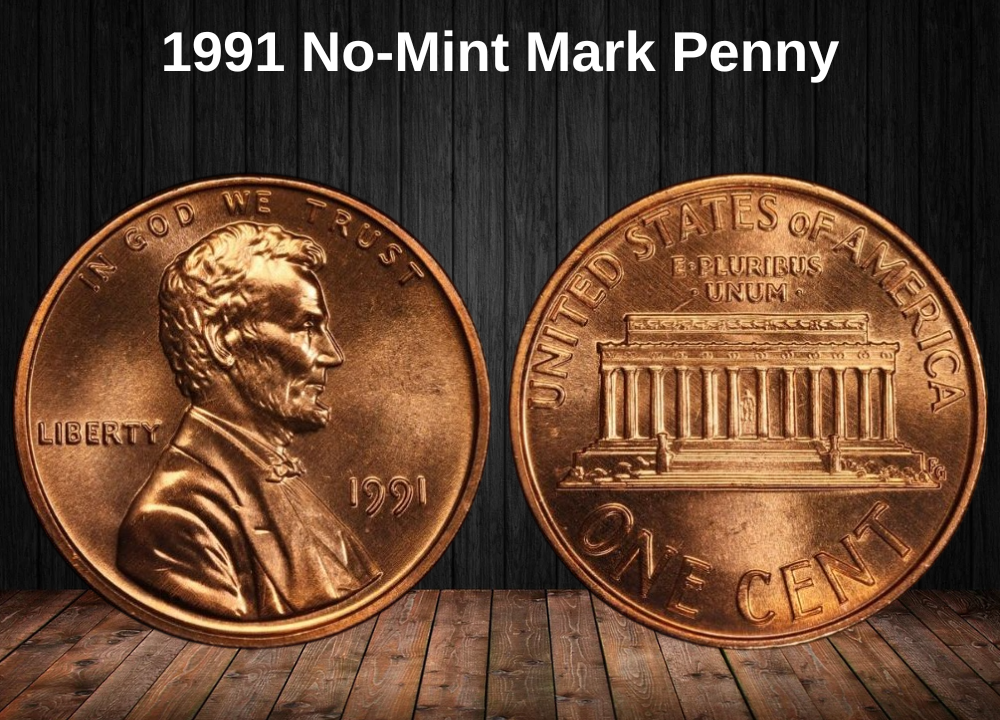
The 1991 Lincoln cent without a mint mark was struck at the Philadelphia Mint, which produced a staggering 5,165,940,000 coins that year. With over 5 billion pennies released into circulation, the 1991 no-mint mark penny is extremely common and readily available.
Rarity and Availability
Due to this massive mintage, the 1991 penny from Philadelphia is:
- Not rare
- Widely circulated
- Easy to obtain, even in mint state
This abundance keeps values modest for most grades.
1991 No-Mint Mark Penny Value
| Condition | Estimated Value |
|---|---|
| Circulated (Average) | $0.05 – $0.10 |
| MS 63 | $6 |
| MS 65 | $10 |
| MS 66 | $15 |
| MS 67 | $34 |
| MS 68 | Up to $340 |
Note: All values are based on red (RD) examples, which are more desirable among collectors.
Record Auction Sale
The highest price ever paid for a 1991 no-mint mark penny was $1,116, achieved at a Heritage Auctions event in 2017. The coin was in superb gem condition, showcasing flawless luster and sharp strike.
Collector’s Insight
While most 1991 pennies won’t make you rich, examples in MS67 and higher, particularly with full red coloration and clean surfaces, can still fetch premium prices. They are ideal for collectors building high-grade Lincoln cent sets.
1991 D Penny Value
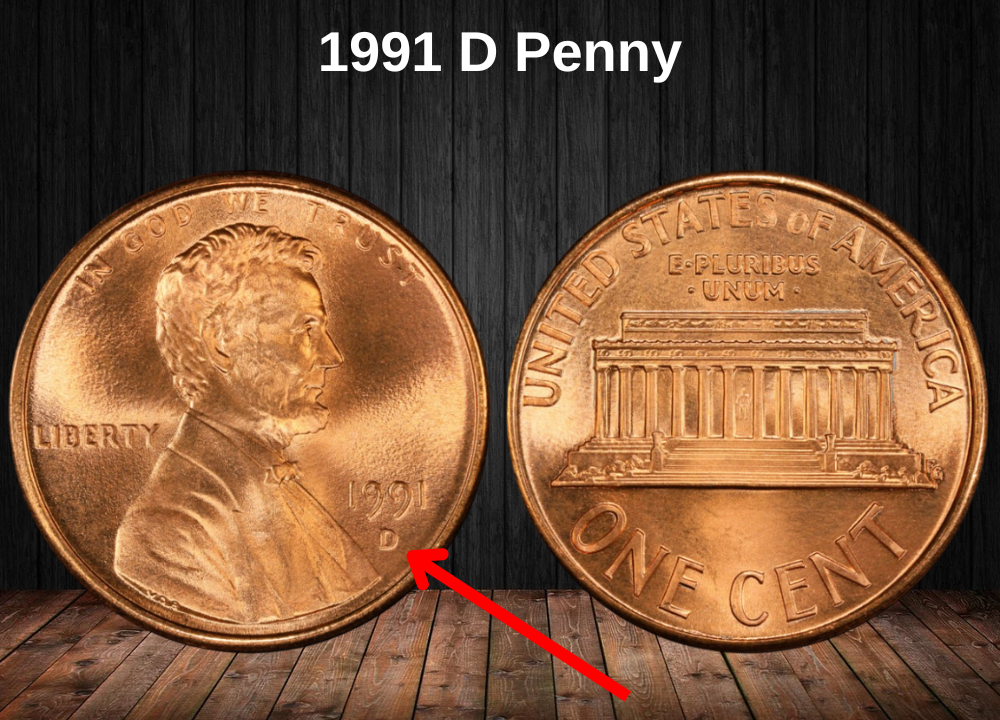
The Denver Mint struck an impressive 4,158,442,076 Lincoln cents in 1991. Like its Philadelphia counterpart, the 1991-D penny is extremely common and easy to find, both in circulation and uncirculated rolls.
1991-D Penny Value
| Condition | Estimated Value |
|---|---|
| Circulated (Average) | $0.05 – $0.10 |
| MS 63 | $6 |
| MS 65 | $10 |
| MS 67 | $26 |
| MS 68 | Up to $130 |
Note: These prices apply to red (RD) coins. Red-Brown and Brown coins are typically worth less.
Collector Insight
- While 1991-D pennies are widely available, gem-quality examples (MS67 and MS68 RD) are harder to come by.
- These high-grade red specimens are valued slightly more, but still remain within reach for most collectors.
- No major varieties or errors are commonly associated with the Denver issues, though off-center strikes and other mint mistakes do exist.
1991-S Proof Penny Value
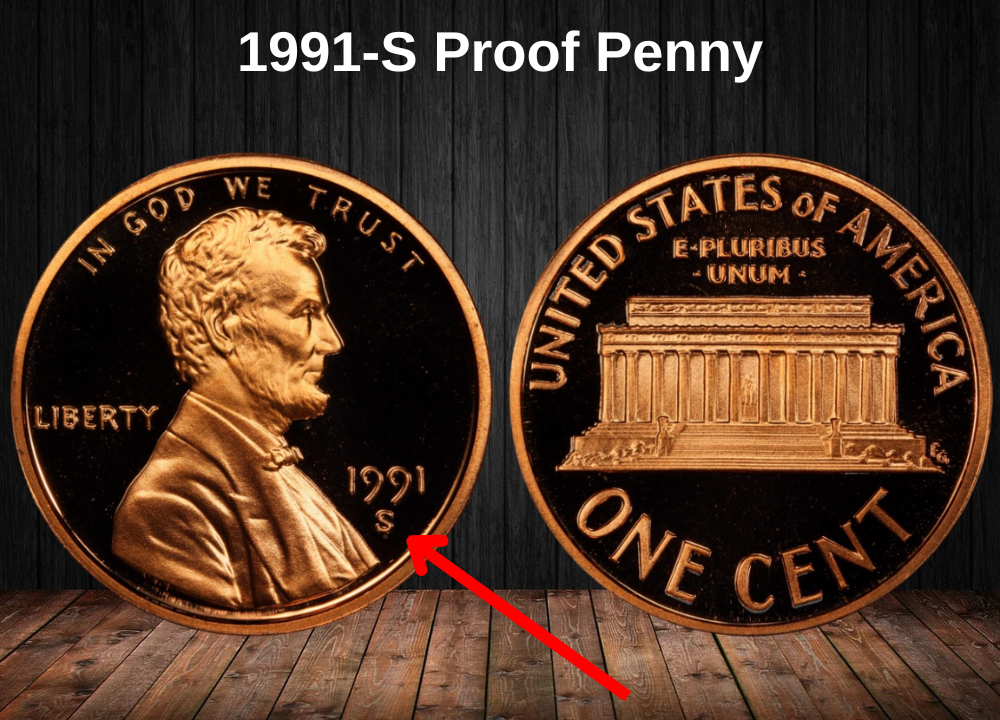
In addition to regular business strikes, the San Francisco Mint produced about 2,800,000 proof Lincoln Memorial cents in 1991.
Proof coins are not meant for circulation. Instead, they’re struck using specially prepared dies and polished planchets, resulting in coins with mirror-like fields, frosted devices, and sharp details. These coins are typically sold in proof sets to collectors.
1991-S Proof Penny Value
| Grade | Estimated Value |
|---|---|
| PF 65 | $4 |
| PF 68 | $7 |
| PF 70 | $45 |
PF = Proof (as graded by NGC), equivalent to PR (used by PCGS)
Collector Insight
- 1991-S Proof pennies are common, given their high mintage and the fact that many remain in collector hands or original proof sets.
- Even top-graded examples like PF70 Deep Cameo are relatively affordable, often selling for under $50.
- Despite their beauty and quality, their market value remains modest due to the large supply.
Rare 1991 Penny Errors List
1991 Doubled Die Reverse (DDR) Penny Error
Doubled die errors occur during the die creation process, not during the actual striking of the coin. These errors happen when the die receives multiple impressions from the hub at slightly different angles, causing parts of the design to appear doubled on the coins it strikes.
How to Spot the 1991 DDR Error
On the 1991 Lincoln Memorial cent, doubling may be visible on the reverse, particularly in areas such as:
- UNITED STATES OF AMERICA
- ONE CENT
- Portions of the Lincoln Memorial
Some coins may also show obverse doubling, especially on:
- IN GOD WE TRUST
- LIBERTY
Use a jeweler’s loupe or microscope to confirm the doubling—look for clear, split serifs and separation lines rather than simple blurriness or wear.
1999 Die Chip Penny Error
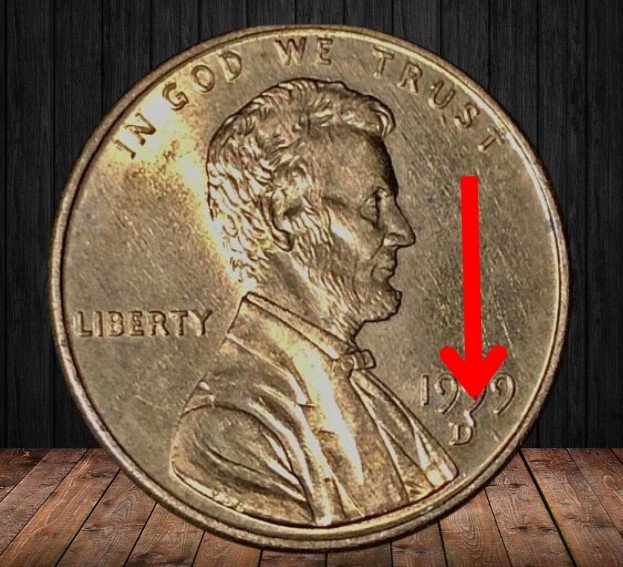
A die chip error happens when a small piece of the die—either on the obverse or reverse—breaks off or cracks during use. This flaw transfers onto the coins struck afterward, leaving raised, irregular lumps or blobs of metal on the coin’s surface.
Identifying Die Chip Errors on the 1991 Penny
For 1991 Lincoln Memorial cents, die chips are most commonly found on the reverse, particularly around the right-side columns of the Lincoln Memorial building. These raised imperfections stand out as odd “blobs” or lumps disrupting the otherwise smooth design.
Value of 1991 Die Chip Errors
- In circulated condition, these errors typically add modest value.
- However, if you own a mint state 1991 penny with a pronounced die chip, it can be worth up to $100 or more to collectors interested in error coins.
Collector Tips
- Use a magnifying glass to inspect your pennies carefully for die chips.
- Photograph any suspected errors clearly to verify with coin experts or grading services.
- The size and location of the die chip significantly impact value; larger and more visible chips usually fetch higher prices.
1991 Strike Through Penny Error
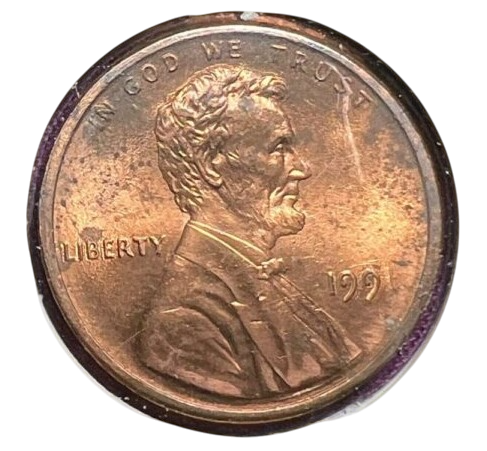
Strike-through errors occur when a foreign object—like grease, dust, or tiny debris—gets trapped between the coin blank and the striking die during minting. When the die presses down, the object prevents a full strike in that area, leaving an impression or distortion on the coin’s surface.
What to Look For
- Irregular marks or depressions on the coin that don’t belong to the normal design.
- Distortions often appear as blobs, smudges, or areas where the metal looks pushed aside or raised.
- These flaws are usually random and unique to each coin.
Value
- While regular 1991 Lincoln pennies have low value, a mint state 1991 strike-through error penny can fetch around $25 or more.
- This represents a good premium for collectors interested in error varieties.
Collector Advice
- Inspect your coins carefully under magnification for unusual raised or depressed areas.
- Strike-through errors are less common than regular pennies, making them an interesting collectible without a steep price.
Where to sell your penny?
Now that you know the value of your penny, you might be wondering where to sell it. Don’t worry: here’s a guide to some of the best online platforms where you can easily sell your coins, along with their advantages and disadvantages.
Discover the best platforms for selling coins online (pros and cons).
FAQ about the 1991 penny
1. What mint marks were used for the 1991 Lincoln penny and how do their mintages compare?
In 1991, pennies were minted at:
- Philadelphia (no mint mark)
- Denver (D)
- San Francisco (S, proof only)
The Denver Mint produced the highest number of circulation strikes, Philadelphia produced slightly fewer, and San Francisco exclusively produced proofs. The large mintages make most 1991 pennies common, but certain errors and proof varieties add interest.
2. Are there any notable error varieties or minting anomalies for the 1991 Lincoln penny?
Yes, common error varieties include:
- Double die obverse, especially noticeable on “LIBERTY” and “IN GOD WE TRUST”
- Off-center strikes
- Die cracks and cuds
- Clipped planchets
While not extremely rare, well-preserved error specimens can be valuable.
3. How did the composition and metallurgy of the 1991 penny affect its appearance and durability?
Like all post-1982 pennies, the 1991 cent is made of 97.5% zinc core with a 2.5% copper plating. This composition can lead to:
- Vulnerability to plating flaking and zinc corrosion
- Potential for spotting and surface degradation if exposed to moisture
Proper storage is essential for maintaining condition.
4. What subtle design features distinguish the 1991 penny from earlier years in the Lincoln Memorial series?
The 1991 penny retained the classic Lincoln Memorial reverse but exhibits:
- Slight modifications in the sharpness of details due to wear on dies
- Variations in mint mark size and placement (especially on Denver coins)
- Minor differences in the appearance of Lincoln’s facial features caused by die polishing
These nuances interest die variety collectors.
5. What is the significance of proof coins from 1991, and how rare are proof errors from that year?
Proof coins from 1991 (minted at San Francisco) are prized for their mirror-like finish and sharp detail. Proof errors like the missing mint mark (No S proof) or double strikes are extremely rare and highly sought after by collectors.
6. How does the 1991 penny’s condition affect its value in today’s market?
Most circulated 1991 pennies have little premium, but:
- Uncirculated MS-65 or better specimens with full red luster (RD) can be worth several dollars.
- Coins with error varieties or proof-like surfaces can be worth significantly more.
7. Are there any known varieties involving die clashes or doubled dies that collectors should watch for in 1991 pennies?
Yes, die clashes causing small, raised features on Lincoln’s cheek or the Memorial steps are documented. Also, some 1991 coins show evidence of doubled dies, particularly on the inscriptions. These varieties add an extra dimension of collectibility.


















































